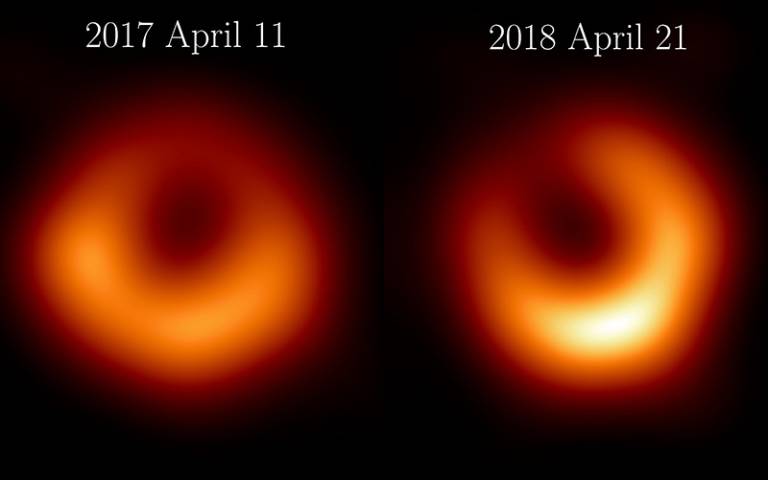New image of supermassive M87* black hole one year on
18 January 2024
The global Event Horizon Telescope (EHT) collaboration involving UCL researcher Dr Ziri Younsi has released new images of M87*, the supermassive black hole at the centre of the galaxy Messier 87.

The new images are from observations taken in April 2018, one year after the first observations of M87* in April 2017 which resulted in the first ever image of a black hole.
They reveal a familiar, bright ring of emission of the same size as was found in 2017. The brightness peak of the ring has shifted by about 30º compared to the images from 2017, which is consistent with theoretical understanding of variability from turbulent material around black holes.
The EHT collaboration, involving more than 300 researchers, uses observations from a worldwide network of radio telescopes and the new images feature the first participation of the newly commissioned Greenland Telescope as well as a dramatically improved recording rate across the array of telescopes. The images are presented in a paper in the journal Astronomy & Astrophysics.
Dr Keiichi Asada, of the Academia Sinica Institute for Astronomy and Astrophysics in Taiwan, said: “A fundamental requirement of science is to be able to reproduce results.
“Confirmation of the ring in a completely new data set is a huge milestone for our collaboration and a strong indication that we are looking at a black hole shadow and the material orbiting around it.”
Dr Ziri Younsi (Mullard Space Science Laboratory at UCL), who is also a member of the EHT Science Council, said: “These independent new data provide important validation of our previous results.
“It is very exciting that over the course of a year, the brightest part of the bright ring encircling the black hole shadow has shifted by about 30 degrees.
“This shift is something that was predicted in 2019 and is wonderful to now observe, showing the turbulent and dynamical nature of the supermassive black hole as matter orbits around its event horizon.
“The brightest part of the ring appears brighter as its material is likely coming towards us, but it may also be where the material is more strongly magnetised. It might be that this bright area coincides with the base of the black hole’s jet, as it is about where we would expect this base to be.
“The fact that the ring size remains essentially unchanged, as predicted by Einstein's General Relativity, is also an important finding. It tells us that powerful gravitational lensing of light from the surrounding material is important and this is therefore most likely a black hole with an event horizon.”
The object M87* is the beating heart of the giant elliptical galaxy Messier 87 and lives 55 million light years away from Earth. The first image of the black hole revealed a bright circular ring, brighter in the southern part of the ring. Further analysis of the data also revealed the structure of M87* in polarized light, giving greater insight into the geometry of the magnetic field and the nature of the plasma around the black hole.
The Greenland Telescope joined the EHT for the first time in 2018, just five months after its construction was completed far above the Arctic Circle. This new telescope significantly improved the image fidelity of the EHT array. The Large Millimeter Telescope also participated for the first time with its full 50 m surface, greatly improving its sensitivity. The EHT array was also upgraded to observe in four frequency bands around 230 GHz, compared to only two bands in 2017.
In addition to the groundbreaking science, the EHT also serves as a technology testbed for cutting-edge developments in high-frequency radio interferometry.
Rohan Dahale, a PhD candidate at the Instituto de Astrofísica de Andalucía (IAA-CSIC) in Spain, said: “Advancing scientific endeavours requires continuous enhancement in data quality and analysis techniques. The inclusion of the Greenland Telescope in our array filled critical gaps in our earth-sized telescope. The 2021, 2022, and the forthcoming 2024 observations witness improvements to the array, fuelling our enthusiasm to push the frontiers of black hole astrophysics.”
The image of M87* taken in 2018 is remarkably similar to what was found in 2017. There is a bright ring of the same size, with a dark central region and one side of the ring brighter than the other. The mass and distance of M87* will not appreciably increase throughout a human lifetime, so general relativity predicts that the ring diameter should stay the same from year to year. The stability of the measured diameter in the images from 2017 to 2018 robustly supports the conclusion that M87* is well described by general relativity.
Dr Nitika Yadlapalli Yurk, a former graduate student at the California Institute of Technology (Caltech), now a postdoctoral fellow at the Jet Propulsion Laboratory in California, said: “One of the remarkable properties of a black hole is that its radius is strongly dependent on only one quantity: its mass.
“Since M87* is not accreting material (which would increase its mass) at a rapid rate, general relativity tells us that its radius will remain fairly unchanged over human history. It’s pretty exciting to see that our data confirm this prediction.”
In addition to 2017 and 2018, the EHT conducted successful observations in 2021 and 2022 and is scheduled to observe in the first half of 2024.
Links
- Event Horizon Telescope
- Paper in the journal Astronomy & Astrophysics
- Dr Ziri Younsi’s academic profile
- Mullard Space Science Laboratory at UCL
- UCL Mathematical & Physical Sciences
- UCL News story – ‘First image of black hole at centre of our galaxy’
- UCL News story – ‘Black hole images captured in world first’
Source
Image
- Credit: Ilje Cho / EHT collaboration
Media contact
Mark Greaves
m.greaves [at] ucl.ac.uk
 Close
Close

